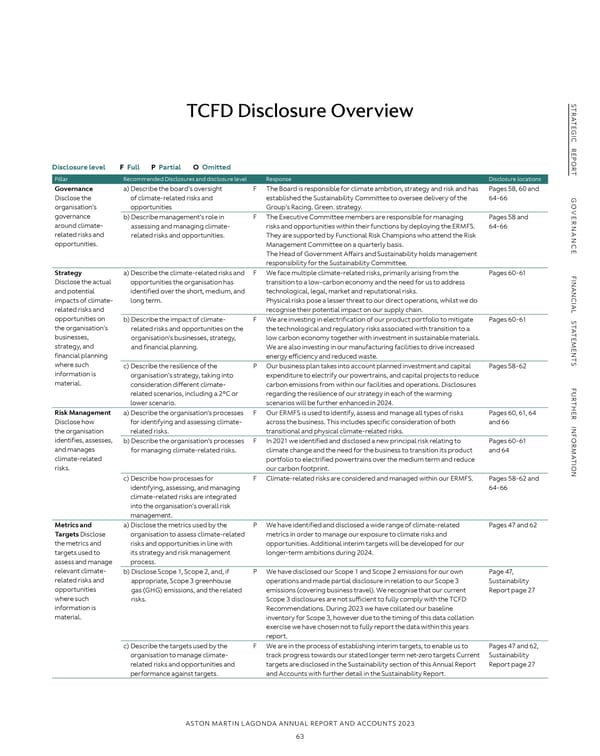S S TR TR A TCFD Disclosure Overview A TE TE G G I I C C R R E E P P O O R Disclosure level F Full P Partial O Omitted R T Pillar Recommended Disclosures and disclosure level Response Disclosure locations T Governance a) Describe the board’s oversight F The Board is responsible for climate ambition, strategy and risk and has Pages 58, 60 and G Disclose the of climate-related risks and established the Sustainability Committee to oversee delivery of the 64-66 G O organisation’s opportunities Group’s Racing. Green. strategy. O VE governance VE b) Describe management’s role in F The Executive Committee members are responsible for managing Pages 58 and R R NAN around climate- assessing and managing climate- risks and opportunities within their functions by deploying the ERMFS. 64-66 NAN related risks and related risks and opportunities. They are supported by Functional Risk Champions who attend the Risk C opportunities. Management Committee on a quarterly basis. C E E The Head of Government Affairs and Sustainability holds management responsibility for the Sustainability Committee. Strategy F a) Describe the climate-related risks and F We face multiple climate-related risks, primarily arising from the Pages 60-61 F I I NAN Disclose the actual opportunities the organisation has transition to a low-carbon economy and the need for us to address NAN and potential identified over the short, medium, and technological, legal, market and reputational risks. C impacts of climate- long term. Physical risks pose a lesser threat to our direct operations, whilst we do C IAL related risks and recognise their potential impact on our supply chain. IAL S opportunities on S b) Describe the impact of climate- F We are investing in electrification of our product portfolio to mitigate Pages 60-61 T T A the organisation’s related risks and opportunities on the the technological and regulatory risks associated with transition to a A T T E businesses, organisation’s businesses, strategy, low carbon economy together with investment in sustainable materials. E M M E strategy, and and financial planning. We are also investing in our manufacturing facilities to drive increased E N financial planning N T energy efÏciency and reduced waste. T S where such S c) Describe the resilience of the P Our business plan takes into account planned investment and capital Pages 58-62 information is organisation’s strategy, taking into expenditure to electrify our powertrains, and capital projects to reduce material. consideration different climate- carbon emissions from within our facilities and operations. Disclosures F F U related scenarios, including a 2°C or regarding the resilience of our strategy in each of the warming U R R T lower scenario. scenarios will be further enhanced in 2024. T H H E Risk Management a) Describe the organisation’s processes F Our ERMFS is used to identify, assess and manage all types of risks Pages 60, 61, 64 E R R INF Disclose how for identifying and assessing climate- across the business. This includes specific consideration of both and 66 INF the organisation related risks. transitional and physical climate-related risks. OR identifies, assesses, b) Describe the organisation’s processes F In 2021 we identified and disclosed a new principal risk relating to Pages 60-61 OR M and manages for managing climate-related risks. climate change and the need for the business to transition its product and 64 M A A T climate-related portfolio to electrified powertrains over the medium term and reduce T I I ON risks. our carbon footprint. ON c) Describe how processes for F Climate-related risks are considered and managed within our ERMFS. Pages 58-62 and identifying, assessing, and managing 64-66 climate-related risks are integrated into the organisation’s overall risk management. Metrics and a) Disclose the metrics used by the P We have identified and disclosed a wide range of climate-related Pages 47 and 62 Targets Disclose organisation to assess climate-related metrics in order to manage our exposure to climate risks and the metrics and risks and opportunities in line with opportunities. Additional interim targets will be developed for our targets used to its strategy and risk management longer-term ambitions during 2024. assess and manage process. relevant climate- b) Disclose Scope 1, Scope 2, and, if P We have disclosed our Scope 1 and Scope 2 emissions for our own Page 47, related risks and appropriate, Scope 3 greenhouse operations and made partial disclosure in relation to our Scope 3 Sustainability opportunities gas (GHG) emissions, and the related emissions (covering business travel). We recognise that our current Report page 27 where such risks. Scope 3 disclosures are not sufÏcient to fully comply with the TCFD information is Recommendations. During 2023 we have collated our baseline material. inventory for Scope 3, however due to the timing of this data collation exercise we have chosen not to fully report the data within this years report. c) Describe the targets used by the F We are in the process of establishing interim targets, to enable us to Pages 47 and 62, organisation to manage climate- track progress towards our stated longer term net-zero targets Current Sustainability related risks and opportunities and targets are disclosed in the Sustainability section of this Annual Report Report page 27 performance against targets. and Accounts with further detail in the Sustainability Report. ASTON MARTIN LAGONDA ANNUAL REPORT AND ACCOUNTS 2023 63
 Annual Report and Accounts Page 64 Page 66
Annual Report and Accounts Page 64 Page 66